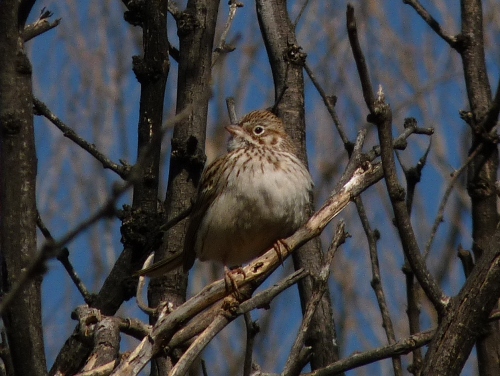|
|
THIS WEEK |
THIS SPRING |
2009 TOTAL |
SITE TOTAL |
|
# birds (and species) banded |
-- |
-- |
32 (6) |
18953 (105) |
|
# birds (and species) repeat |
-- |
-- |
-- |
3348 (65) |
|
# birds (and species) return |
-- |
-- |
6 (4) |
460 (32) |
|
# species observed |
40 |
52 |
61 |
197 |
|
# net hours |
-- |
-- |
24 |
30489.3 |
|
# birds banded / 100 net hours |
-- |
-- |
133.3 |
62.1 |
|
|
Note: table does not include nocturnal banding (owls) |
Bander-in-charge: Marie-Anne Hudson
Censusers: Jean Bacon, Jean Beaudreault, Mike Beaupré, David Bird, Jean De Marre, Samuel Denault, Gay Gruner, Jeff Harrison, Barbara MacDuff, Chris Murphy, Rodger Titman
Notes: What an interesting spring so far! A prominent Quebec birder said it pretty well in an email over a list-serve the other day: spring is coming but winter hasn’t quite left yet. He doesn’t mean weather-wise, but bird-wise. We’re still recording winter species like Slate-colored Junco, Pine Siskin and Common Redpoll despite the fact that we’re also getting more spring-like species such as Great Blue Heron, Killdeer, Eastern Phoebe and Tree Swallow. A neat phenomenon for sure! This interesting mix has led to some great observations: 40 species this week (slightly down from 44 last year at this time), 52 so far this season (up from 48) and 62 for the year (up from 49)! New species for the season include Turkey Vulture, Cooper’s Hawk, Tree Swallow, Barn Swallow, Yellow-bellied Sapsucker, Eastern Phoebe and Common Redpoll (seen throughout the winter but only seen for the first time since the season started on Friday).
This week’s top ten is again pretty similar to last week’s, though we’re sure this will change pretty quickly once the migrants really start pouring in. The top species, Snow Goose, was again vaulted to the top by just one census entry of 670 birds. Though no longer migrants, the two Canada Geese that settled in our back pond are the proud parents of two eggs (so far), laid atop the extremely rickety duck blind. We’re hoping the flooded structure will be able to support the weight of the parents and eggs as long as they need it to.
|
This week's
top 10 [last week's rank in brackets] |
|
#
individuals banded |
mean #
individuals observed daily |
|
- |
1. Greater Snow Goose (95.7) [9] |
|
- |
2. Canada Goose (88.3) [1] |
|
- |
3. Red-winged Blackbird (30.3) [2] |
|
- |
4. American Robin (17.1) [4] |
|
- |
5. American Crow (15.6) [5] |
|
- |
6. Song Sparrow (11.4) [7] |
|
- |
7. Ring-billed Gull (10.0) [3] |
|
- |
8. Black-capped Chickadee (8.9) [8] |
|
- |
9. Cedar Waxwing (8.1) [-] |
|
- |
10. Wood Duck (6.1) [-] |
|
|

Sparrows give many people trouble in terms of identification, and Vesper Sparrow can be especially problematic - especially given that the two species with which it is most easily confused (Song and Savannah) are highly variable in their own appearance. It also doesn't help that many field guides emphasize the chestnut shoulder patch and/or white tail edges, neither of which can regularly be seen on Vesper Sparrows! A better feature to look for is the white eye ring, especially in combination with a lightly streaked breast as on the bird above. Vesper Sparrow is rare at MBO, but flocks of mixed sparrows should be checked closely to see whether any lone individuals are traveling with other more common species.
(Photo by Marcel Gahbauer)
|


